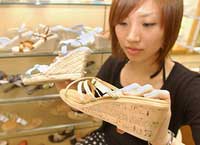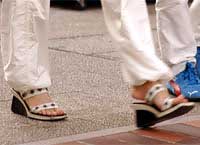|
|
|||||||
|
|
|||||||
|
|||||||
| | Web Japan >> | Trends in Japan >> | Fashion >> | Stepping Out in Wedge-Soled Shoes | |
|
STEPPING OUT IN WEDGE-SOLED SHOES Women Choose Cute and Comfortable Summer Shoes (May 31, 2005) The wedge-soled shoes that were popular among Japanese women in the early 1980s are making a comeback in the summer of 2005. Style-conscious women are adding the thick-soled shoes to their wardrobes as an expression of this spring and summer's fashion watchwords, "resort" and "vacation." And it is not only style but comfort, too, that is a big factor in the popularity of wedge-soled shoes. Many wearers report that the large surface area of the shoes' soles lightens the burden on their feet. Making a Comeback The wedge sole was created by Salvatore Ferragamo, founder of the Ferragamo brand, who produced soles made of materials such as cork during World War II. In Japan, wedges first appeared in the 1970s, but only as a brief fad. A full-blown craze erupted in the early 1980s as part of the new-traditional fashion trend. This trend was defined by a single style: a pump-like shoe with a jute-wrapped sole. The current wedge craze is marked by much greater variety, manifesting itself in an array of designs and sole materials. As one might expect of a summer fashion trend, sandals that enable wearers to show off the bridges of their feet are popular. Soles also come in a range of materials, including clear plastic as well as cork and rattan. Designs vary widely. The sides of the soles may be embroidered with flower patterns or adorned with ribbon, and the shoe may have a narrow heel and a slight arch at the sole, giving it the elegance of a high-heeled shoe. Or the heel may have a slightly exaggerated curve. From Resorts to the Street
Wedge-soled shoes are also finding favor for their functionality. In contrast to the pin-heeled mules that have been popular for the past few years, wedges distribute the body's weight over the entire surface area of the sole, reducing the load on the feet. As shoes offering the leg-lengthening effect of high heels without the pain associated with that style, wedges are finding a loyal following not only among young women buying them for the first time but also among 40-something women who wore them back in the 1980s. Among the latter group, the affection for wedge-soled shoes is no doubt tinged with nostalgia. Copyright (c) 2005 Web Japan. Edited by Japan Echo Inc. based on domestic Japanese news sources. Articles presented here are offered for reference purposes and do not necessarily represent the policy or views of the Japanese Government. |
SPLIT-TOE SOCKS (March 18, 2005) PSYCHEDELIC REVIVAL (March 16, 2005) |
|||||
|
||||||





